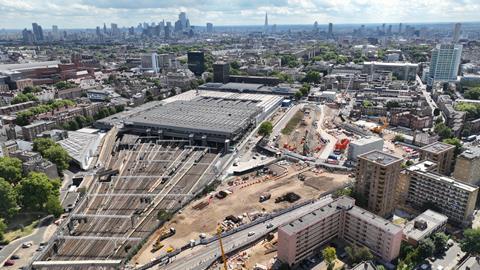
UK: The Department for Transport ‘still does not know what it is trying to achieve’ with the High Speed 2 station at London Euston ‘despite spending over eight years planning and designing it’, according to a highly critical report from the House of Commons Public Accounts Committee issued on July 7.
The committee said HS2 Euston ‘is yet another example of the department making the same mistakes and failing to learn lessons from its management of other major rail programmes’, and parliament ‘has also not had the full transparency it needed on the likelihood of cost increases’.
In March, DfT announced that it would be pausing new construction work at Euston for two years. The estimated cost has reached £4·8bn, compared to the original £2·6bn budget which the committee said had been ‘completely unrealistic’.
Responding to the committee report, a DfT spokesperson said ‘we made the decision to rephase the construction of Euston to help balance the nation’s books and work on an affordable design for the station. The National Audit Office recently acknowledged this will provide time to put the station design on a more stable footing’.
Six recommendations
The committee has made six recommendations in its report, which DfT said it would respond to in due course:
1. DfT needs to use the pause to establish the design and expectations for the station against what it is willing to spend;
2. DfT needs to be much clearer to parliament and the public that the revised budget it sets is realistic and the design is affordable and deliverable;
3. DfT should produce an interim report in three months setting out how it and HS2 Ltd are managing the costs of the pause, how much has already been spent, and how much more they expect to spend. HS2 Ltd should also include the proportion of the supply chain at Euston, in particular SMEs, that has been re-employed elsewhere on HS2;
4a. DfT should agree with the Treasury and report back to PAC in six months on how it will manage the continued consequences of high inflation;
4b. The Treasury should set out to the committee how it will work with all departments to manage the consequences of high inflation on major capital programmes;
4c. DfT should also set out the requirements to access the government contingency on the HS2 programme;
5a. DfT should provide, as part of its six-monthly updates to parliament on the HS2 programme, clear explanations of the maturity of its cost estimates and the risks that could result in material changes;
5b. Concerns about the updates to parliament which were raised by the Transport Select Committee should be addressed;
6. DfT needs to demonstrate that it is embedding the lessons from past rail projects and not just repeating the same mistakes. This should include measures to address costs overruns and identify who is responsible, applying lessons from Euston to Birmingham Curzon Street and Manchester Piccadilly, and managing the integration of work at Euston once DfT has decided what it wants to achieve.
‘The HS2 Euston project is floundering’, said PAC Chair Dame Meg Hillier. ‘Forging ahead over-optimistically in an unclear direction is clearly not the right approach.’



